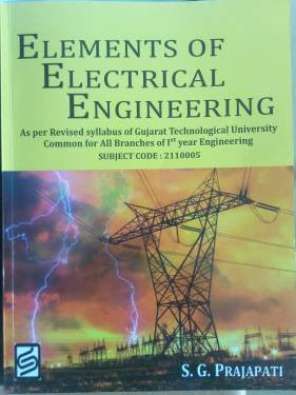PART- 1: D.C. Circuit
1. Elementary Concepts
1.1. Basic concepts of voltage, current, Resistance Power And Energy
1.2 Sources of Electrical Energy
1.3. Ideal Electric Circuit Elements
1.4. Fundamental Laws of Electric Circuit
1.5. Analysis of Series, Parallel and Series Parallel Circuits.
1.6. Delta Star And Star-Delta Transformation
1.7. Node And Mesh Analysis
2. Electrostatics
2.1 Electrostatics
2.2. Capacitor
3. Electromagnetism
3.1. Introduction
3.2. Terms Related To Magnetic Circuit
3.3. comparision Between Electric and Magnetic Circuit
3.4. Magnetic Hysteresis
3.5. Hysteresis and Eddy Current Loss
3.6. Magnetic Materials
3.9. Rise and Decay of Current in an Inductive Circuit
3.10. Energy Stored In An Inductor
3 11. Force Experinced by current carrying conductor Placed in Magnetic Field
PART 2: A, C Circuit
4. Single Phase Circuits
4.1 Introduction
4.2 Generation of single phase Alternating Voltages.
4.3. Terms Related To AC Circuit
4.5. AC Series Circuits
5. Three Phase A. C. Circuits
5.1. Introduction
5.2. Generation of 3-Phase Voltages
5.3. Interconnection of3-Phases.
5.4. Advantages of 3 Phase Circu
5.5. Terms Related To 3-Phase Circuit
5.7. Measurement of 3-Phase Power
5.8. Measurement ol Power Factor By Two Wattmeter Method
5.9. Wattmeter Reading at Different Power Factor
PART 3: Batteries, wiring illumination & electrical safety
6 Batteries and Fuel cell
6.1. Introduchan
6.2. The Simple Cell
6.3. Batteries
6.4. Fuel Cell
7 Electrical Wiring
7.1. INtroduction
7.2. Types of Wires and Switches
7.3. Connectors and Switches
7.4. wiring Diagram From Electric Pole To Energy Meter To sub Circuit
7.5. Electical Domestic Wiring
7.6. Induotrial Electrification
8. Illumination
8.1. Introduction
8.2. Terms Related To Illumination
8.3. Electric Lamp
8.4. Fixtures & Reflectors
8.5. Lightning Schentese
8.6. Larmen Required For Different categories
9. Safety & protection
9.1. Introduction
9.2. Safety
9.3. Earthing /Grounding
9.4. Circuit Protection Devices


